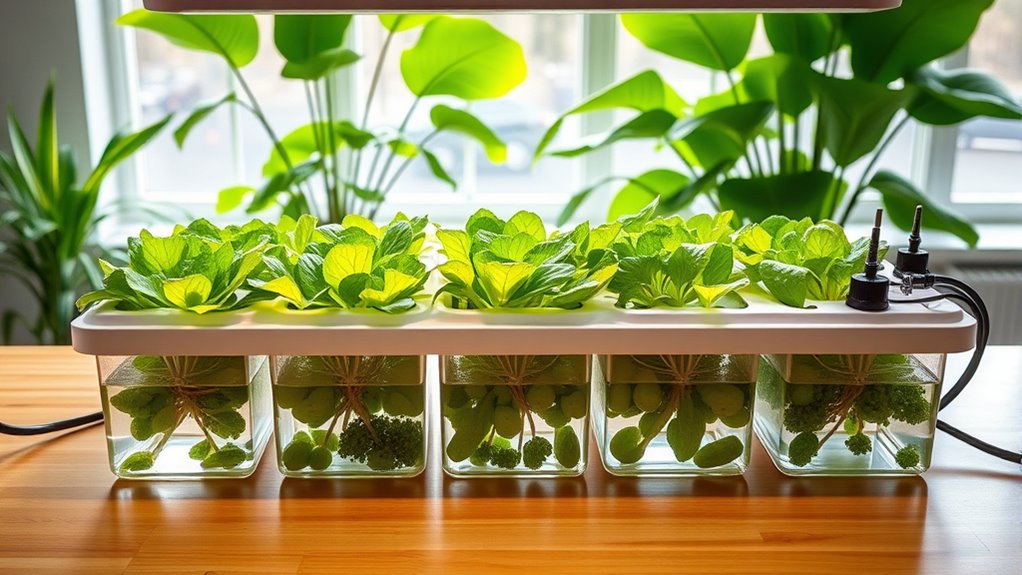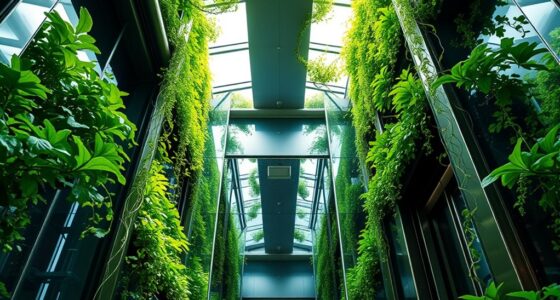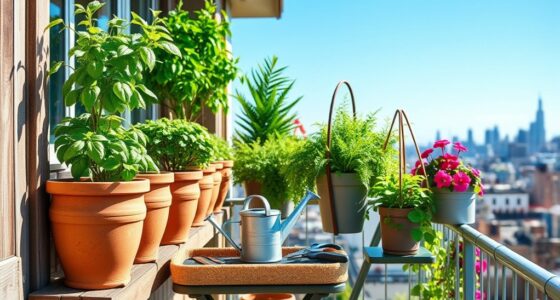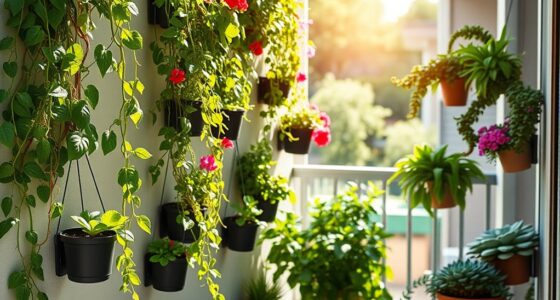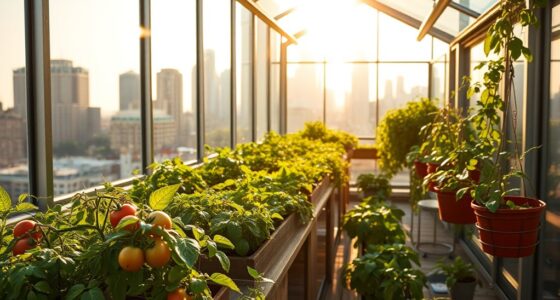Hydroponics is a method of growing plants without soil by delivering nutrient-rich water directly to their roots. You set up a system using a reservoir, support containers, and an aeration system to keep roots oxygenated. Popular types include Nutrient Film Technique and Deep Water Culture, perfect for home use. Managing light, water, and nutrients is key to success. Keep exploring to find out how to create your own soil-free garden at home.
Key Takeaways
- Hydroponics is a soil-free method of growing plants using nutrient-rich water solutions directly delivered to roots.
- Essential components include a reservoir, growing medium or no medium, oxygenation system, and proper pH management.
- Popular systems like NFT and DWC maximize water and oxygen access, supporting rapid plant growth at home.
- Proper lighting, environmental control, and nutrient management are crucial for healthy plant development indoors.
- Regular system maintenance and troubleshooting ensure optimal growth and prevent issues like nutrient deficiencies or pests.
What Is Hydroponics and How Does It Work
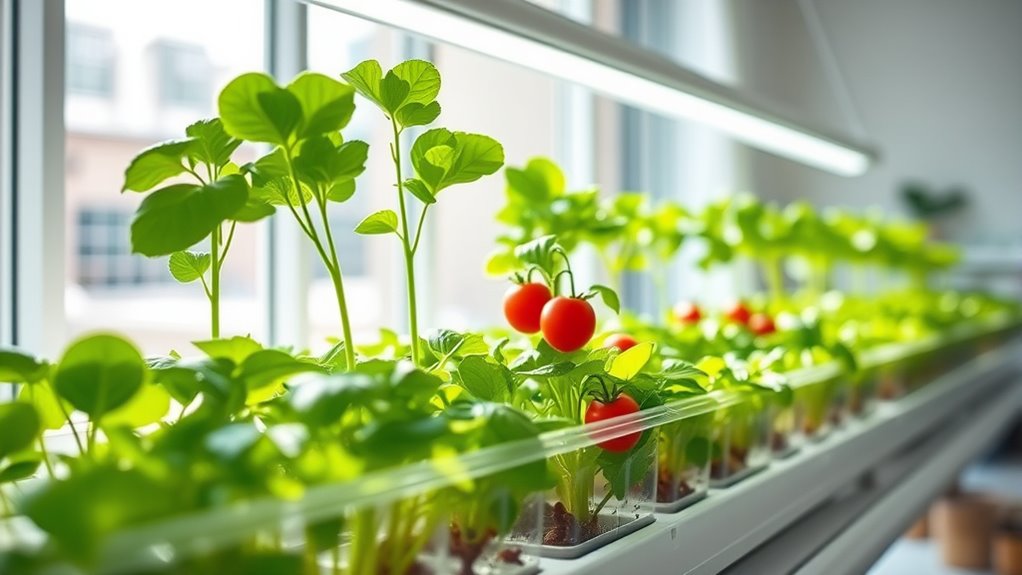
Hydroponics is a method of growing plants without soil by delivering nutrient-rich water directly to their roots. In this system, water carries essential nutrients like nitrogen, phosphorus, potassium, and trace elements straight to the roots, promoting faster growth and higher yields. You can support your plants with inert media such as rockwool or clay balls, or grow them with no medium at all, as in aeroponics. The system relies on efficient delivery of water, oxygen, and nutrients through techniques like nutrient film, deep water culture, or ebb-and-flow. To maximize growth, grow lights provide the necessary light spectrum, ensuring your plants thrive even indoors. This precise control over the nutrient solution makes hydroponic growing highly effective and adaptable for home cultivation. Additionally, understanding the costs involved in setting up and maintaining a hydroponic system can help you plan a budget-friendly and sustainable soil-free gardening setup at home. Proper monitoring of pH levels and nutrient concentration is crucial for optimal plant health and productivity. Regularly checking the water quality and maintaining system cleanliness can prevent diseases and ensure consistent crop yields. Furthermore, integrating modern equipment such as automated timers and sensors can enhance your system’s efficiency and consistency. Recognizing the importance of plant compatibility can help tailor your hydroponic setup to different types of plants for better results.
Essential Components for Soil-Free Cultivation
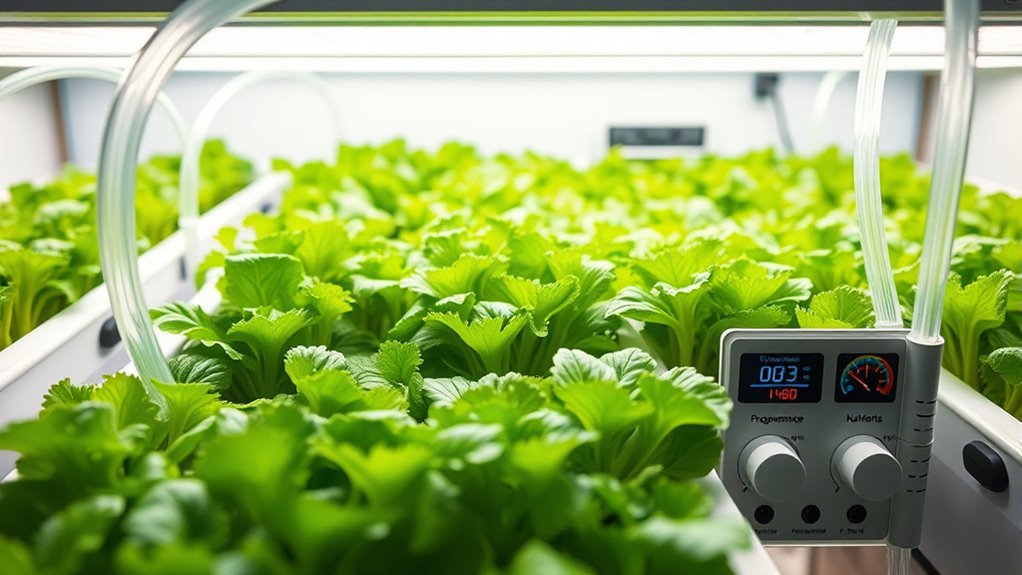
To successfully grow plants without soil, you need several essential components that work together to create an effective soil-free environment.
A reservoir holds water mixed with vital nutrients like nitrogen, phosphorus, and potassium, delivering them directly to your plant’s root system.
The roots are supported by a growing medium, such as net cups or mesh pots, which hold the plants and allow easy access to the nutrient solution. Using a growing medium that provides proper support and drainage is key to healthy root development.
An air pump and stones oxygenate the water, ensuring your plant roots receive enough oxygen and preventing suffocation. Proper lighting systems promote healthy growth, while maintaining optimal pH levels—usually between 5.5 and 7.0—is crucial for nutrient absorption. Regular water testing helps maintain the right balance for optimal plant health.
Oxygenate your water with an air pump and stones to keep roots healthy and prevent suffocation.
Using a reliable filtration system can also help remove airborne pollutants and maintain a clean environment for your plants air purification. Additionally, monitoring water quality regularly ensures that your nutrient solution remains balanced and effective for healthy plant development. Incorporating automation technology can further optimize nutrient delivery and environmental conditions, making soil-free gardening more efficient and manageable.
These components work together to maintain a balanced, healthy environment for your plants to thrive.
Popular Types of Hydroponic Systems
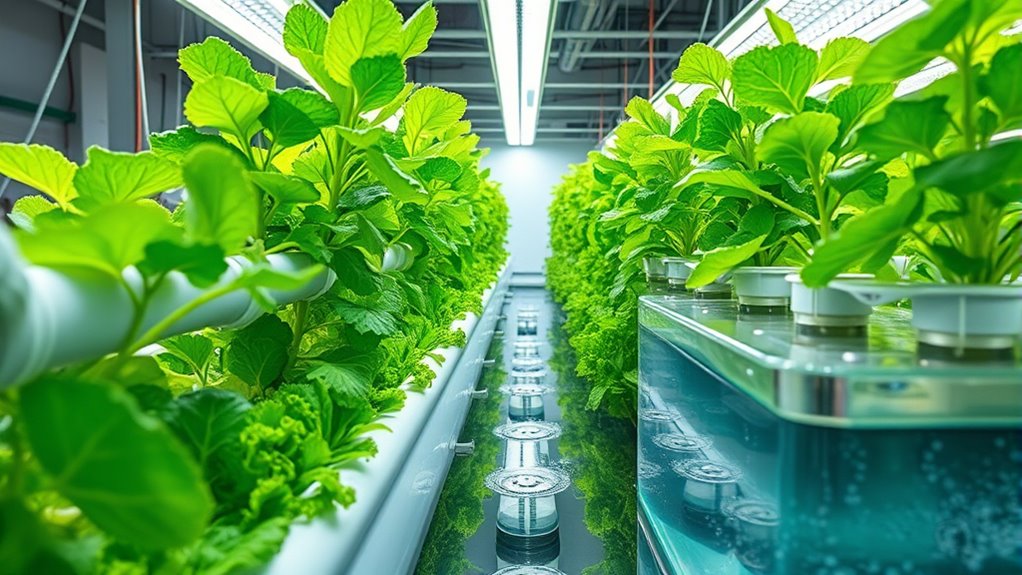
There are several popular hydroponic systems you can try at home, each suited to different needs and space.
For example, Nutrient Film Technique (NFT) offers a gentle flow of nutrients over plant roots. This method is efficient for growing leafy greens and herbs with minimal water use.
Deep Water Culture suspends roots directly in oxygenated water for quick growth. The oxygenation process is crucial to prevent root rot and promote healthy development. Proper oxygen levels are vital for maintaining plant health in this system.
Wick systems use simple capillary action, making them perfect for beginners. They are especially suitable for small-scale setups or indoor gardening.
Aeroponics mists roots in a closed environment for high-value crops. This system can maximize growth rates but requires precise control of misting intervals. Understanding system maintenance ensures optimal performance and crop yield.
Additionally, airless sprayers can be used for applying nutrients or pest control solutions efficiently in larger setups. This approach helps maintain uniform coverage and reduces waste.
NFT and Deep Water
Among the popular hydroponic systems, Nutrient Film Technique (NFT) and Deep Water Culture (DWC) stand out for their efficiency and ease of use. NFT uses a nutrient film of water flowing over plant roots in shallow channels, ensuring constant nutrient delivery and aeration. DWC suspends roots directly in oxygenated, nutrient-rich water, promoting rapid root growth. Both systems are perfect for soil-free gardening, especially for leafy greens and herbs. They maximize water circulation and oxygen access, leading to faster, healthier growth. Understanding the underlying hydroponic principles can help optimize these systems for better yields. For instance, proper oxygenation is essential for healthy roots, which is why aeration techniques are a key part of system design. Additionally, selecting appropriate growing media can support plant stability and nutrient uptake. Here’s how they compare:
| Aspect | NFT | DWC | Why Choose? |
|---|---|---|---|
| Water Use | Minimal, recirculates water | Continuous nutrient immersion | Efficiency & sustainability |
| Aeration | Through water flow | Air stones oxygenate water | Healthy root development |
| Setup | Shallow channels, sloped | Sturdy container, air pump | Ease of maintenance |
Wick and Aeroponics Systems
Ever wondered how simple it can be to start a hydroponic garden at home? Wick and aeroponics systems are perfect for small-scale, indoor gardening. These passive systems require minimal equipment and maintenance.
- Wick systems use capillary action to draw nutrient solution from a reservoir to the roots via absorbent materials like cotton or felt, supporting plant growth without pumps or timers.
- Aeroponics suspends roots in a sealed chamber and mists them with a nutrient-rich solution, providing high oxygen exposure that accelerates growth.
- Both are ideal for herbs and leafy greens, offering straightforward hydroponic setups that promote healthy root development and faster plant growth in a compact space.
Setting Up a Home Hydroponic Garden
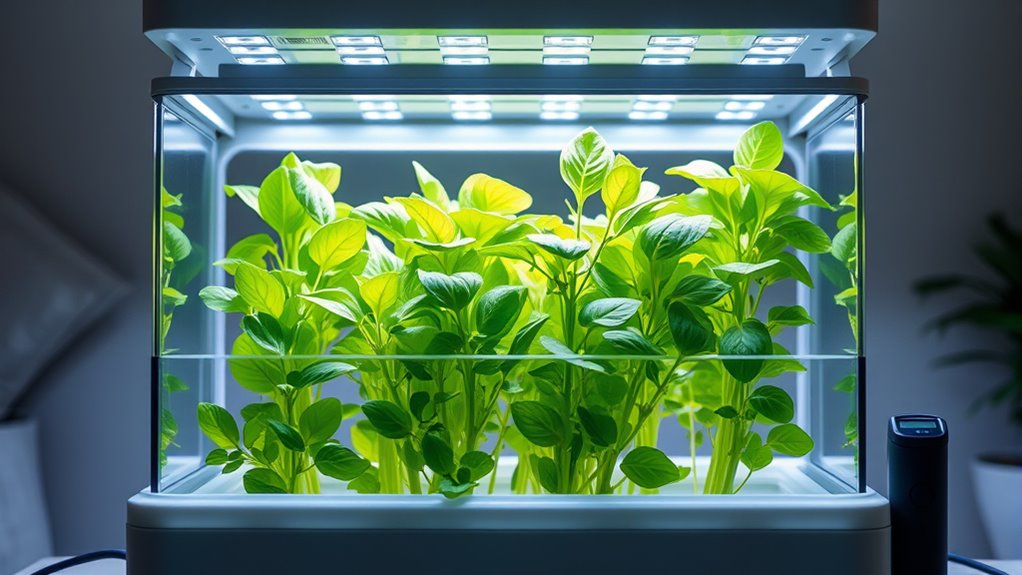
Setting up a home hydroponic garden starts with choosing a suitable container, such as a clean plastic tote or reservoir made from non-toxic materials. This forms the foundation for your hydroponic system setup.
Drill or cut holes in the lid to securely fit mesh pots or net cups for plant support.
Prepare the nutrient solution according to manufacturer instructions, then aerate it with an air pump and stone for 20-30 minutes to promote water aeration.
Install the air stone connected to the pump to oxygenate the water and support healthy root systems.
If you’re growing indoors, position grow lights close enough to provide sufficient spectrum for plant growth.
Regular system maintenance guarantees healthy growth, ideal water quality, and efficient nutrient delivery for a thriving hydroponic garden.
Growing Crops in a Hydroponic Environment
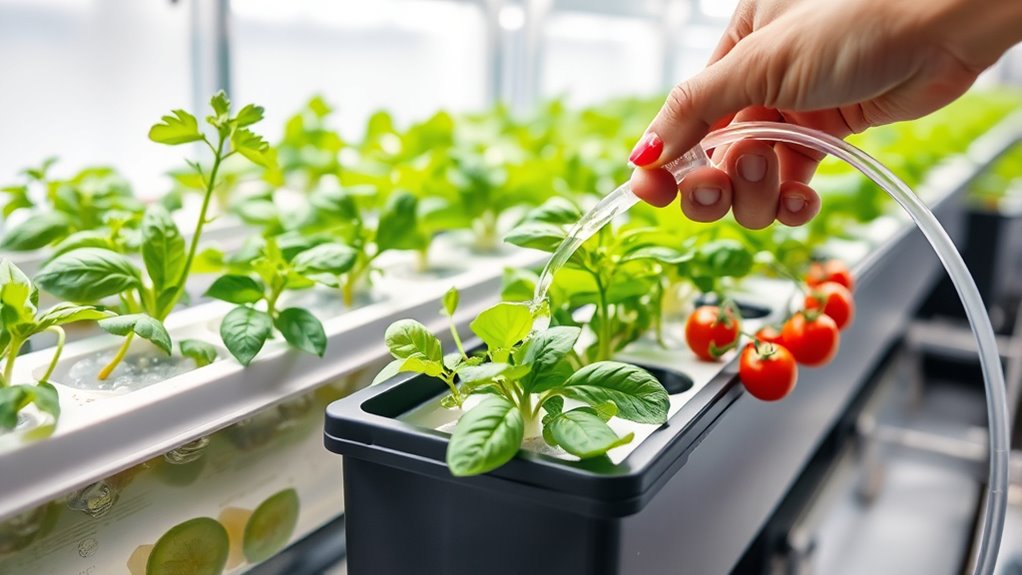
Choosing the right crops is key to success in your hydroponic garden, whether you prefer quick-growing herbs or larger fruits like tomatoes. You’ll need to adjust lighting and environmental conditions to suit each plant’s needs, ensuring healthy growth. Proper nutrient management is essential, so you’ll want to tailor your strategies based on your crops and setup for the best results. Additionally, understanding self-watering plant pots can help maintain consistent moisture levels and reduce watering frequency, contributing to healthier plants in your hydroponic system. Incorporating hydroponic nutrient solutions can further optimize plant health by providing essential nutrients directly to the roots.
Optimal Crop Choices
What crops are best suited for growing hydroponically at home? You’ll find that leafy greens, herbs, and certain fruit-bearing crops excel in hydroponic systems.
- Leafy greens like lettuce, spinach, and arugula are ideal because of their short growth cycles and low nutrient requirements, enabling quick harvests.
- Herbs such as basil, mint, cilantro, and parsley thrive with minimal space and effort, offering continuous yields.
- Fruit-bearing crops like strawberries, tomatoes, and cucumbers can also grow successfully, especially in controlled environments with proper nutrient management.
When selecting crops, consider their growth rate, nutrient needs, and space. Short-season crops and microgreens are perfect for multiple harvests per year, maximizing your system’s efficiency.
Lighting and Environment
To guarantee healthy growth in your hydroponic system, providing the right lighting and environment is critical. Proper grow lights, whether natural sunlight or artificial lighting, support photosynthesis and plant development. High-intensity discharge (HID) lights like MH and HPS suit different growth stages, while fluorescent grow lights like T5s are energy-efficient choices for seedlings. Indoor hydroponics require environmental control of temperature, humidity, and a consistent light schedule—around 14-18 hours of light daily. The grow lights spectrum influences plant health, and managing light intensity ensures ideal growth. Adjusting these factors creates a favorable grow environment, promoting vigorous growth and higher yields. Air quality management is also important in maintaining optimal conditions for plant health. Additionally, monitoring nutrient levels ensures plants receive the essential nutrients for optimal growth. Compliance requirements in a Hydroponic environment include maintaining proper lighting and environmental conditions to optimize plant health and productivity. Creativity in optimizing environmental conditions can lead to innovative solutions for efficient plant cultivation.
Nutrient Management Strategies
How can you guarantee your hydroponic crops receive the right nutrients? Start by regularly monitoring pH levels, aiming for 5.5 to 6.5, to assure nutrient availability.
Use Electrical Conductivity (EC) measurements to track nutrient concentration and prevent over- or under-fertilization.
Prepare nutrient solutions according to manufacturer instructions, carefully measuring macro- and micronutrients for ideal nutrient balance.
Choose appropriate fertilizer blends—such as complete, two-part, or dry fertilizers—to tailor nutrient ratios to your crop’s needs.
Remember to replace the entire nutrient solution every 1-2 weeks to prevent salts buildup, which can hinder nutrient uptake.
Consistent monitoring of nutrients helps identify plant deficiencies early and adjusts hydroponic nutrients accordingly for healthy, vigorous growth.
Additionally, understanding fertilizer blends and their specific nutrient profiles can significantly improve crop health and yield in hydroponic systems.
Managing Light, Water, and Nutrients

Managing light, water, and nutrients effectively is essential for a successful hydroponic system. Proper water management involves maintaining ideal pH levels between 5.5 and 7.0 and regularly checking nutrient solutions to prevent deficiencies or toxicities. Ensuring appropriate nutrient concentration and electrical conductivity helps plants absorb nutrients efficiently.
Aerate nutrient solutions to boost oxygen availability, which supports healthy root development and prevents root diseases caused by over-saturation. Monitoring water temperature is vital, as it influences nutrient uptake and oxygen levels.
Adequate lighting, whether natural or artificial, promotes photosynthesis. Indoor setups often use LED grow lights operated 14-18 hours daily. Consistent management of these factors encourages vigorous plant growth and higher yields in your hydroponic systems.
Troubleshooting Common Challenges

Even with careful attention to light, water, and nutrients, hydroponic systems can face common challenges that hinder plant growth. To keep your system healthy, focus on:
- Monitoring pH levels regularly (aim for 5.5 to 6.5) to prevent nutrient lockout and ensure plants absorb nutrients properly.
- Maintaining proper aeration with air stones or pumps to avoid oxygen deficiency and root diseases.
- Performing system cleaning at least monthly to prevent algae growth, bacterial buildup, and root diseases like Pythium.
Watch for pests such as aphids or mites, and address nutrient deficiencies by adjusting nutrient concentrations based on plant signs and EC readings.
Consistent system maintenance helps catch issues early and keeps your hydroponic garden thriving.
Frequently Asked Questions
What Are the Initial Costs to Start a Home Hydroponic System?
Starting a home hydroponic system costs vary, but you should expect to spend around $50 to $200 initially. You’ll need basic supplies like a container, water pump, growing medium, and nutrients.
If you opt for a more advanced setup, costs can rise. Keep in mind, investing in quality equipment helps guarantee a successful, low-maintenance garden.
Planning your system carefully can save you money in the long run.
How Much Maintenance Does a Hydroponic Garden Require Weekly?
You’ll need to check your hydroponic system weekly, but maintenance isn’t too demanding. Expect to monitor nutrient levels and pH regularly, adjust as needed, and inspect for pests or diseases.
You’ll also want to clean pumps or filters and guarantee your water stays fresh. Overall, it’s a manageable routine that keeps your plants healthy, and with consistent care, you’ll enjoy a thriving garden without much hassle.
Can Hydroponic Systems Be Scaled up for Commercial Use?
You can definitely scale up hydroponic systems for commercial use. With proper planning, you’ll need larger setups, more nutrients, and efficient water management.
You’ll also want to invest in automation and monitoring technology to keep everything running smoothly. As you expand, it’s vital to optimize airflow, lighting, and nutrient delivery to guarantee healthy plant growth.
Commercial hydroponics can be highly productive if you maintain consistent quality and manage your resources well.
What Are the Best Plants for Beginners in Hydroponics?
Think of hydroponics as a garden on steroids—fast, efficient, and rewarding.
As a beginner, you’ll find lettuce, spinach, and herbs like basil or mint are your best friends. They grow quickly, forgiving mistakes, and don’t demand much space. Starting with these plants helps you learn the ropes without feeling overwhelmed.
Soon, you’ll be harvesting fresh greens right from your setup, turning your thumb green in no time!
Is Hydroponic Gardening More Environmentally Friendly Than Traditional Gardening?
You might find that hydroponic gardening is more environmentally friendly than traditional gardening because it uses less water and resources. Since you control nutrient delivery precisely, there’s less runoff and waste.
Plus, it often requires fewer pesticides and chemicals, which benefits your local environment.
Conclusion
Think of your hydroponic garden as a lush oasis you’ve created inside your home, where plants dance happily without soil’s embrace. With the right setup, you’re the gardener guiding a vibrant, thriving ecosystem. As you tend to your soil-free paradise, remember that patience and care are your best tools. Soon, your indoor garden will flourish like a well-tuned symphony, turning your space into a green sanctuary filled with fresh, homegrown bounty.
